System analysis
Overview
Research on the neede cost and technology to realize RP laser propulsion. By analysing these aspects, it is possible to understand the missions that are achievable by laser propulsion.
Flight analysis of RP laser propulsion system
The feasibility of a RP laser system launch to the aaaaaaaaaaaaa (GEO) was conducted.
The analysis conducted so far are
1 Proposal of an efficient orbit for RP laser propulsion
2 Flight analysis to calculate the maximum payload launchable per laser power
3 Calculation of mission cost by RP laser propulsion
1 Proposal of an efficient orbit for RP laser propulsion
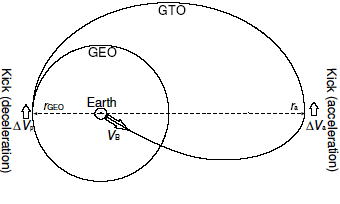
In the proposed orbit, the vehicle is firstly accelerated to a speed higher than the speed required for the GEO. After that the vehicle is put into the GTO (Geo-Transfer-Orbit) by using a kick motor at the apogee point. Finaly the vehicle is decelerated at the perigee point to be placed in the GEO. Since the vehicle is accelerated at once near the ground, the proposed orbit only requires one laser on the ground. It can also keep laser dissapation caused by the atmosphere, and errors in the vehicle angle at a minimum because the vehicle is launched straight upwards from the ground. Launching the vehicle straight upwards also makes it easier for the laser beam to track the vehicle.
2 Flight analysis to calculate the maximum payload launchable per laser power
By calculating the relation between laser power and thrust in many modes, it is possible to conduct a flight analysis of the mission proposed above. From flight analysis, the height and velocity of the vehicle are obtained, making it possible to know the payload ratio, and minimum laser power to launch the veihicle using an RP laser.
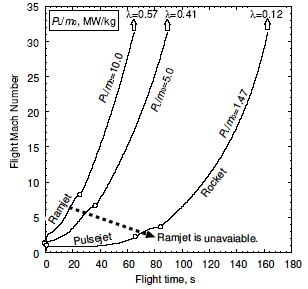
The image above is the result of the flight analysis, showing the time evolution of speed (Mach number) of the vehicle. Each line represents a different condition of initial vehicle weight to laser power (PL/m0). The timing to change between pulse-jet mode, ram-jet mode, and rocket mode were determined by the engine cylcle analysis shown below. Ram-jet mode was considered to be used from, the point where thermal chocking occured at position 3, to when thrust and drage were equivilant due to the decrease in density of the atmosphere.
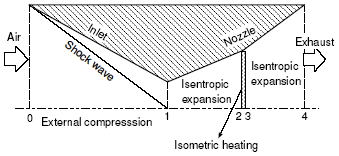
From these results, the relationship between initial weight by laser power (PL/m0), and payload mass by laser power (mpayload/PL) was obtained.
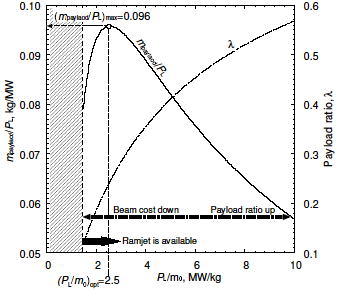
As seen above, when PL/m0 was 2.5 MW/kg, the launch was most efficient, and mpayload/PL took a maximum value of 0.096 kg/MW. If the laser power were too small, it took a long time to accelerate, causing the vehicle to fly in rocket mode for a long time, which caused the payload ratio to decrease. When the laser power was too large, the vehicle would be accelerated to a high speed in an altitude where the atmosphere density was still high, causing loss due to big drag. From this analysis, it aws shown that there is an optimal laser power for every mission.
3 Calculation of mission cost by RP laser propulsion
In an RP laser launch system, the construction fee of the laser facility is the biggest problem. Although the facility is expensive, it can be used many times after construction. This means that if maintanence fees are ignored, the cost per lauch will decrease as the amount of launches increase. To evaluate the cost, a mission to lauch a 100 ton solar pannel to the GEO was analized. The cost included the construction fee of facilities, cost of the vehicle, and cost of electricity needed. The calculated cost was compared with the cost required to accompish the same mission using the H2A rocket(a conventinal chemichal rocket).
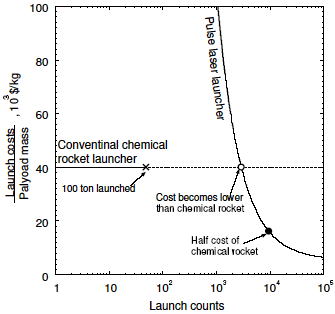
In the graph above, the cost of lauhching 1 kg of mass to GEO using RP laser propulsion and conventinal rockets are compared. When RP laser propulsion is used over 10000 times (in the mission above, 10 kg at a time), the cost of laser propulsion would be half the cost of conventional rockets. If the payload (in this case 100 tons of solar pannels) were even heavier, and could be divided into more than 10000 groups, the cost would become even more cheap. If the energy source were to be in the microwave reigion, the ground facilities would be much cheaper than using lasers.
10000 launches would require 30 launches a day to be complete in 1 year. Altough it would be difficult to launch 30 chemical rockets a day, the method proposed above is considering a vehicle that is only around 100 kg and can be launched within 3 minutes as shown above.